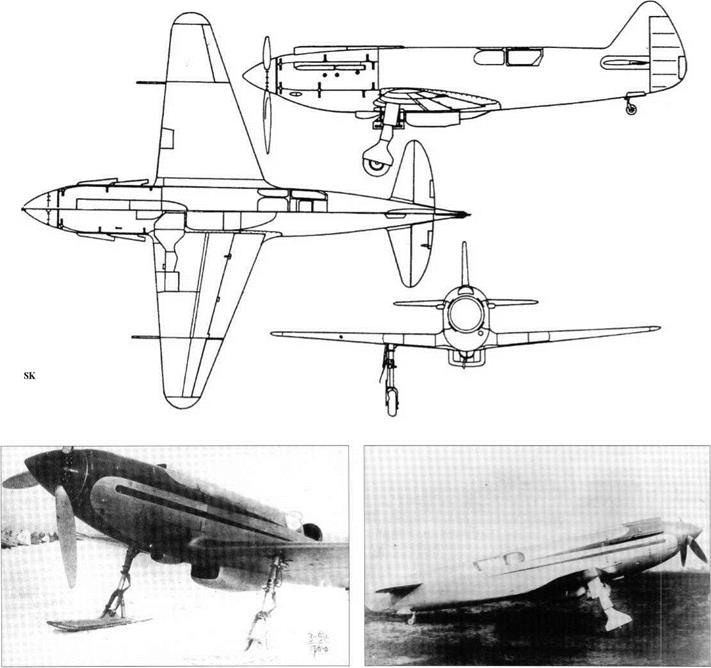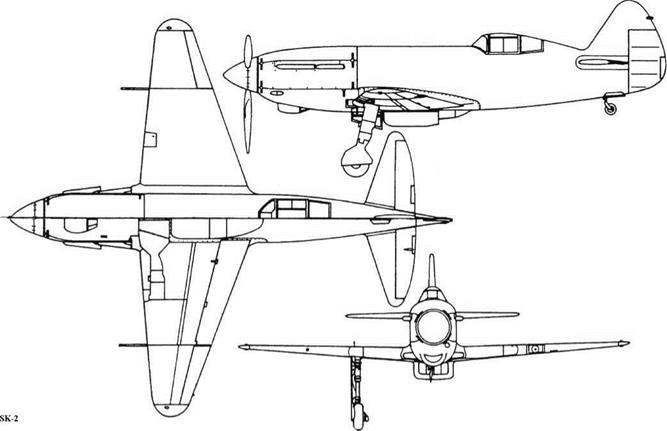BICh jet project
Purpose: To design a jet fighter.
Design Bureau: B I Cheranovskii.
Again, the three-view drawing of this project was discovered only recently. There is no evidence that construction was even started. The drawing is dated 1944, at a time before any German turbojets had been captured but after publication of the existence of British and US engines of this type. The only turbojet then running in the Soviet Union was the Lyul’ka VRD-2, a slim axial-compressor engine rated at 700kg (1,543 Ib) thrust. This was probably the engine Cheranovskii had in mind.
The configuration appears to be an outstanding one, similar to many fighter projects of the present day. The engines were to have been buried inside the broad and flat deltashaped wing, there being no fuselage. The drawing shows the location of the cockpit, two large guns, nosewheel-type landing gear and four fuel tanks. Each wing carried a single control surface with a balancing area
ahead of the hinge. Clearly each surface acted as a dual-function eleven. There was no vertical tail, just like today’s ‘stealth’ pro
posals, and this could have made engine-out situations difficult.
A truly remarkable project. No data.
Bisnovat SK
Purpose: Experimental high-speed aircraft. Design Bureau: OKB of Matus Ruvimovich Bisnovat, Moscow.
In the mid-1930s Bisnovat was working in the newly formed OKO of VKTairov (pronounced tyrov), at Kiev. In 1938 he was permitted to organise his own team of design engineers in order to build and test the fastest aircraft possible, for research into wing profiles, structures, flight controls and other problems. This was a time when aircraft technology was making rapid progress. Initially his production base was the Central Workshops of CAHI (TsAGI), but by 1939 this group was transferred to his own account.
Contracts were signed for two aircraft designated SK and SK-2. The former was to be the research aircraft, while the SK-2 was to have a conventional cockpit canopy and be capable of carrying armament and other military equipment. Surprisingly no documents appear to have been found recently giving details of this programme. All we have is Shavrov’s Vol.2 (published 1978 but written much earlier) which says the SK ‘was completed on skis in early 1939’, and an article written in 1977 by Konstantin Kosminkov which says flight testing began ‘at the start of 1940’. There is little doubt the latter date is correct. The first series of photographs, show
ing the aircraft on its wheeled landing gear, are dated ’20/1 40′ (Roman I, ie January). The SK did not fly in this form until later, and flight testing began on non-retractable skis. The first photographs on skis were taken on ‘ 17/II 40’. Flight testing of the SK-2 began on 10th November 1940, and was completed on 10th January 1941. The pilot assigned to the programme was Georgi Mikhailovich Shiyanov.
The SK was a beautiful-looking low-wing monoplane of diminutive proportions (making the l,050hp M-105 engine occupy nearly half the fuselage), entirely of light-alloy stressed-skin construction except for the fabric-covered ailerons and rudder. The wing was of NACA 23014.5 (14.5% thick) aerofoil profile, with wide-chord Vlasov (slotted split) flaps inboard of the ailerons. Structurally the wing was based on a Spitfire-like box with a heavy leading edge extending back to the single main spar. The ribs were Duralumin pressings. The outer surface (apparently of the wing only) was covered with marquisette (a fine light fabric) and powdered cork, all held by nitrocellulose glue. When fully set the surface was ‘polished to the brilliance of a mirror’.
The small wing was made in one piece and designed so that it would be simple to fit different wings to the fuselage. The latter had a cross-section of only 0.85m2 (9.15ft2), this
being the minimum to fit round the engine. The pilot sat in a reclining seat in a cockpit whose canopy was flush with the upper surface. For take-off and landing the roof over the rear half of the canopy could be hinged up and the seat raised to give a forward view. Drag was further reduced by using an engine cooling system filled with water circulating at a gauge pressure of l. lkg/cm2 (15.61b/in2), which enabled the frontal area of the radiator to be only 0.17m2 (1.8ft2), half the normal size. The engine air inlet was underneath, ahead of the radiator, and the oil-cooler inlet on top. The propeller was a VISh-52 of2.95m (9ft Sin) diameter, with three blades with constant – speed control. Other features included 100% mass balance on the elevators and rudder and, according to Kosminkov, a hydraulic system to operate the flaps, pilot seat, cockpit hood and the long-stroke (wheeled) landing gear, which retracted inwards into bays closed by multiple doors. The tailwheel was steerable and fully retractable. The standard of finish was high, and except for fabric areas the surface was polished, with the spinner, nose and a cheat-line painted red.
In fact, in 1939 retractable skis had not yet been developed, and for this reason the SK was initially limited to a modest speed (see data). So far as is known the SK flew well, though Shavrov records that the SK-2 (and by
implication the SK) suffered from various defects which prevented it from being accepted as a fighter.
Compared with the SK, the SK-2 differed most obviously in having a normal cockpit, with a fixed more upright seat and conventional canopy, which could be jettisoned, with a sliding window on the left. The engine installation was modified, with a reprofiled coolant radiator, engine air inlets in the wing roots and the oil cooler under the cowling. This left the area above the engine clear for a neat installation of two 12.7mm BS heavy machine guns with their magazines (Kosminkov states there was a 7.62mm as well). The SK-2
airframe was slightly modified, notably by increasing the height of the fin and the span of the horizontal tail from 2.75m (9ft /4in) to 3.26m (10ft 8%in). This aircraft was painted overall, in a deep colour.
In 1940 these aircraft were the fastest in the Soviet Union, and probably in the world. Despite their ‘hot’ nature, and high wing loading, they appear to have been safe and attractive machines. However, with so many La, MiG and Yak fighters already in production, the SK-2 had little chance of being adopted as a fighter.
|
Dimensions (SK)
|



Top left and right: Two views of SK-2 Dimensions (SK-2)
(on right, note split flaps). Span 7.3m 23 ffllX in
Length 8.285m 27 ft 214 in
Wing area 9.57m2 103 ft2
 |
Opposite page: SK on skis and on wheels.










